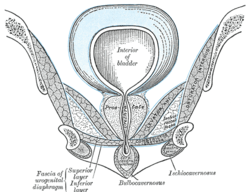Internal obturator muscle
| Internal obturator muscle | |
|---|---|
|
The obturator internus and nearby muscles | |
 Coronal section of anterior part of pelvis, through the pubic arch. Seen from in front. (Obturator internus labeled at right.) | |
| Details | |
| Origin | Ischiopubic ramus & obturator membrane |
| Insertion | Medial aspect of the greater trochanter |
| Artery | inferior gluteal artery |
| Nerve | Nerve to obturator internus (L5, S1, S2) |
| Actions | Abducts & laterally rotates the extended hip and abducts the flexed thigh at the hip, and stabilizes the hip during walking |
| Identifiers | |
| Latin | Musculus obturatorius internus |
| TA | A04.7.02.012 |
| FMA | 22298 |
The internal obturator muscle, obturator internus muscle originates on the medial surface of the obturator membrane, the ischium near the membrane, and the rim of the pubis.
It exits the pelvic cavity through the lesser sciatic foramen.
The internal obturator is situated partly within the lesser pelvis, and partly at the back of the hip-joint.
It functions to help laterally rotate femur with hip extension and abduct femur with hip flexion, as well as to steady the femoral head in the acetabulum.
Structure
It arises from the inner surface of the antero-lateral wall of the pelvis, where it surrounds the greater part of the obturator foramen, being attached to the inferior pubic ramus and ischium, and at the side to the inner surface of the hip bone below and behind the pelvic brim, reaching from the upper part of the greater sciatic foramen above and behind to the obturator foramen below and in front.
It also arises from the pelvic surface of the obturator membrane except in the posterior part, from the tendinous arch which completes the canal for the passage of the obturator vessels and nerve, and to a slight extent from the obturator fascia, which covers the muscle.
The fibers converge rapidly toward the lesser sciatic foramen, and end in four or five tendinous bands, which are found on the deep surface of the muscle; these bands are reflected at a right angle over the grooved surface of the ischium between its spine and tuberosity.
The tendon inserts on the greater trochanter of the proximal femur.
The internal obturator muscle is also innervated by the nerve to internal obturator (L5, S1).

Bursa/bands
This bony surface is covered by smooth cartilage, which is separated from the tendon by a bursa, and presents one or more ridges corresponding with the furrows between the tendinous bands.
These bands leave the pelvis through the lesser sciatic foramen and unite into a single flattened tendon, which passes horizontally across the capsule of the hip-joint, and, after receiving the attachments of the superior and inferior gemellus muscles, is inserted into the forepart of the medial surface of the greater trochanter above the trochanteric fossa.
A bursa, narrow and elongated in form, is usually found between the tendon and the capsule of the hip-joint; it occasionally communicates with the bursa between the tendon and the ischium.
Additional images
| Dissection images |
|---|
|
References
This article incorporates text in the public domain from the 20th edition of Gray's Anatomy (1918)
External links
- -1348861872 at GPnotebook
- Anatomy photo:13:st-0407 at the SUNY Downstate Medical Center - "Gluteal Region: Muscles"
- Anatomy photo:43:st-0603 at the SUNY Downstate Medical Center - "The Female Pelvis: Muscles"
- Cross section image: pelvis/pelvis-e12-15 - Plastination Laboratory at the Medical University of Vienna
- pelvis at The Anatomy Lesson by Wesley Norman (Georgetown University) (femalepelvicdiaphragm, malepelvicdiaphragm)
- perineum at The Anatomy Lesson by Wesley Norman (Georgetown University) (analtriangle3)
- Int. J. Morphol., 25(1):95-98, 2007
